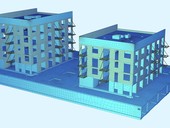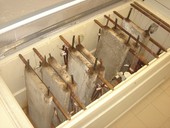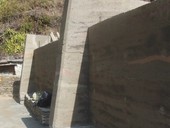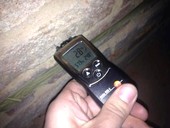BIM processes have brought to the design process improvement in co-ordination between different professions and, in the case of the statics profession, facilitating the creation of a load-bearing structure model. The duplicate work was removed, where the same structural elements had to be modeled by two offices, both architectural and static. In addition, these models are now interconnected and coordinated. In this article, we will present the entire process on a project of the load-bearing structure of a set of apartment buildings with a common underground floor. It is designed on the basis of current European standards using BIM processes for its design and drawing documentation.
Archiv článků od 3.9.2018 do 18.3.2019
Current trends and methods of production of steel for the reinforcement, quality grades and their graphic representation. Welding problematics of steel for the reinforcement of concrete, specifics affecting the quality of welds of reinforcing steel. Process approach to welding of reinforcing steel, welding processes, types of welds, their advantages and disadvantages. Qualification of welders and welding coordinators for welding of reinforcing steel, qualification of welding procedures, production tests and acceptance crireria of the organization for welding of reinforcing steel.
Durability is described as the ability of a material to maintain its physical and mechanical properties over time. In reinforced concrete (RC) structures, concrete is the ideal material to protect the steel reinforcement. However, the RC structures are exposed to environmental loads, which cause the deterioration of materials as corrosion of reinforcement. The standard STN EN ISO 9224 describes the calculation of the whole corrosion loss. Despite these calculations, it is appropriate to perform the measurements on the real samples, which are time consuming. For this reason, it is useful to use accelerated corrosion test. The basis of our research was to compare the results of thickness of corrosion loss in accelerated corrosion test according the standard STN EN ISO 9227 with the calculation of corrosion loss according the standard STN EN ISO 9224.
An example of reliability verification of existing concrete member represent an extension of previous authors contribution “New European document for assessment of existing structures”. The illustrative example of the member is based on the new Technical specification [2]) and valid Eorocodes ČSN EN 1990 [7] and ČSN EN 1991-1-1 [9]. The contribution should provide background information supporting implementation of the new European document on assessment of existing structures to national standards.
The upcoming CEN Technical Specification (TS) on assessment of existing structures is related to the fundamental concepts and requirements of the current generation of EN Eurocodes. The final draft of the Technical specification was already submitted to the technical committee CEN TC250 in April 2018. The document concerns all types of buildings, bridges and construction works, including geotechnical structures, exposed to all kinds of actions. It contains requirements, general framework of assessment, data updating, structural analysis, different verification methods (partial factors, probabilistic methods, risk assessment), interventions, heritage building. The submitted contribution provides background information on the principles accepted in the final draft of TS and practical examples of applications of existing structures including panel buildings.
Paper deals with the definition of energy flexible building, its impact on the stability of the grid with the planned increasing share of energy from renewable sources and the possibility of using the heat storage capacity of building structures. Paper further analyzes the selected methodology for evaluation of the energy flexibible building and gives an example of thermally activated building structures.
The article deals with a design of very slender steel columns loaded in compression. The design resistance of common compression columns results from the buckling resistance, which is due to a high slenderness low. Modification of a common column into a stayed prestressed system leads to a multiple increase of its design resistance. The article describes prestressed steel stayed columns with one central crossarm. First the formulas for critical loads of “ideal stayed columns” are presented, second the formulas for maximal resistances of “imperfect stayed columns” are given. The reduction of the maximal resistances by a material partial safety factor results into a design resistances in accordance with Eurocode 1993-1-1. Finally a solved example is presented with a comparison of resistances received for the prestressed (stayed) column and non-prestressed (common) column with a very high slenderness.
The subject of this paper is an experimental and numerical analysis of the stability of the wall panels with one-side board sheating. The reinforcement of the panel is provided by means of glued timber composite I-shaped element consisting of a web made of a wood-based desk embedded into flanges of solid timber. The mechanism of the behaviour of these panels, mode of the failure and reliable procedure to determine the buckling load-bearing capacity not been fully explored so far. The main aim of this project is to create reliable numerical model using experiments and parametric study for optimized design. Outcome of the work is a design model and dimension tables for one-side board sheating wall panels of light timber structures with a rib in the form of an I-stud.
Fluid fuel combustion technology in coal-fired power plants is also very popular in the Czech Republic, resulting in a relatively high production of a specific by-product – fluidized fly ash, which differs from the classical high-temperature fly ash in mineralogical composition with a high sulphur content of anhydrite CaSO4. Fluidized ash is not yet used in the production of fired building materials, where it could be used as a cheap source of calcium oxide (for example, the production of porous ceramic tiles). However, the issue of sulphur dioxide leakage during the re-firing of fluidized fly ash in ceramic raw materials mixtures has to be solved. This paper deals with the analysis of the basic properties of domestic fluidized fly ash and provides a reflection on its possible use in building production.
Dowel joints with wooden fasteners are an important part of many timber structures. They have been used especially in historical timber structures. This type of fasteners can be used for the construction of modern wooden structures or for the production of individual wooden structural elements, such as the Holz100 system of the Austrian company Thoma or for similar Brettstapel structural elements. Actual normative materials (principally Eurocode 5) do not provide sufficient safe design description for such structural joints. A complex model of failures in different directions to the grain of wood is missing. The article focuses on a pilot study on the evaluation of mechanical behaviour of dowel joints and presents the results of experiments of all-wood joints with dowels made of various wood species.
The mechanical properties of earthen building material have been intensively investigated for the last fifty years. Different earth mixtures are used for different building technologies, such as walls, bricks or plasters. Therefore, it is almost impossible to set a specific numerical value for a parameter in general. These values may vary significantly and are listed within range. The properties of each earth mixture are dependent on the clay content (type of clay minerals), filler, water and additives. Depending on the building technology several tests can be performed to determine the mechanical properties. This review article discusses mechanical properties of earth, the tests and limit values. These properties include density, binding force, compressive strength, tensile strength, bending tensile strength, bond strength, resistance to abrasion, modulus of elasticity and impact strength of corners.
The paper summarizes latest research on the influence of natural clay materials and earth structures on the quality of indoor microclimate regarding relative humidity. This laboratory research has been carried out at FCE CTU in Prague and UCEEB CTU in Prague and focuses on the dynamic sorption properties of building structures based on natural clays compared to building structures based on common building materials.
Earth is one of the oldest building materials and in many countries still the most common building material, often preffered for its low cost and self-construction possibilities. Also in Europe, soil was used for centuries as a building material and nowadays expanding again because of it´s enviromental characteristics. Unfortunatelly, traditional unstabilized earth buildings are vulnerable to earthquakes and as many earthen buildings are located in earthquake prone areas, serious damages and life-threatening collapse of many houses occurs regullary. This article shows possibilities of seismic protection and earthquake resistant construction techniques of traditional earthen buildings.
Analysis and design of reinforced concrete structures requires knowledge of the mechanical properties of the materials used. In the case of nonlinear analysis, a higher range and detail of mechanical properties of concrete is needed. The article focuses on the description of strength characteristics of concrete, attention is paid to the strength of concrete in the tension. The testing was focused on the split tension test and the three-point and four-point bending test. The obtained mechanical properties of concrete are subsequently applied in the nonlinear analysis of reinforced concrete beam without shear reinforcement, which has been subjected to a load test.
The clay bricks produced by extruding (continuous compression) generally have a high proportion of clay. The use of this bricks in buildings is beneficial in terms of the amount of built-in clay in building structures. The positive effects of these clay materials in the living space are generally known, however, using as a support for clay plaster has some difficulties, which are less known. The issue of the application of clay plaster in extruded clay bricks is the subject of my long-term interest.
Concrete is a composite material with significantly different value of tensile and compressive strength. Tensile strength is usually only 1/10 of compressive strength. With admixture of steel fibers it is possible to enlarge the tensile strength. The paper deals with testing and consequent determination of tensile strength of fiber concrete with the amount of fibers 25, 50, 75 kg/m3. Four series, each with more than 23 specimens, were tested. Tensile strength testing implied a few variant of bending test with different span (500 mm or 600 mm), different load configuration (three or four point bending), with or without notch. Results of cube and cylindrical compressive strength and transverse tensile strength are also presented.
Building objects that have been severely damaged by an explosion of explosives, gas or technological breakdowns threaten surrounding area by their unstable state. Their damage is usually so severe that no repair or reconstruction is considered, and the only possible solution is quick demolition. In these risky situations, the emergency state of the building can be advantageously solved by using special charges with an effect which will ensure a rapid reconstruction of the unstable state of the building without endangering the environment, especially in built-up areas of cities.
Due to increasing amount of construction and demolition waste (C&DW), new recycling methods and applications of secondary raw materials are searched. The biggest part of C&DW is old concrete and mortar which can be used for production of recycled concrete aggregates (RCA). To protect the nature and decrease amount of mined natural aggregates, RCA could partially or totally replace natural aggregates used for production of new concrete. This article presents the factors which have influence on the RCA properties. Properties of three different types of RCA were analysed and results compared with properties of natural aggregates. Description of connection between factors and properties of RCA are discussed. Results showed that not only origin and amount of impurities has influence on applicability of RCA as a replacement of natural aggregates for new concrete production.
Almost all types of building structures in our environment are affected by rising wetness. Especially in old historical buildings this could produce huge problem in the statics. One of the most efficient and suitable solutions of this problem is to create waterproofing injection screen in the base of the structure. This screen is realized by gels, that are injected into the lines of boreholes and subsequently penetrates the building material thus create the screen that stops water from rising above it further into the structure. To examine functionality of the injection gels and their ability to create injection screen in various types of building materials also various types of mason mortar must be tested, because of their ability to transmit the injection gel in its structure.
The trend of the earth building material use is not only for plaster but also for the construction of buildings, as well as repairs of clay buildings, which also require the need to determine the load-bearing capacity of whole walls, not just bricks. The loadability of the walls and the influence of moisture on brick strength have been subjected to experimental investigation of SHS o.s. within the framework of the OP HRD project, the load-bearing capacity of the pillars was examined by FA and FAST staff within the BUT grants.
zpět na aktuální články



















